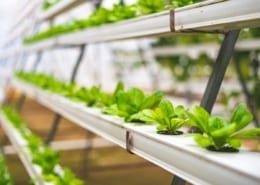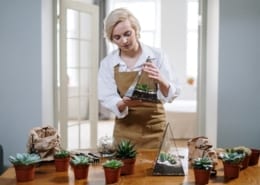Aquaponic production is a food production system that combines hydroponics (cultivating plants in water) with aquaculture (raising aquatic animals in tanks). Some people operate large-scale commercial aquaponic farms, however you can also practice the principles of aquaponics in your own backyard!
The Certificate of Aquaponic Production is a professional development course that will teach you the fundamentals of aquaponic plant culture and how to successfully set up an aquaculture system.
In this aquaponic farming course, you will learn about different aquaponic systems, the science of plant and animal growth, and how to control the nutrition of your own system.
You will also discover how to select and manage the right combination of plant and animal life, how to troubleshoot potential issues, and how to manage an aquaponics venture yourself.
On completion of this course you will be able to set up, maintain and even profit from what many believe is the future of sustainable farming!
Course Structure
Unit - Aquaponic Production
Unit 1 – Introduction
- What is aquaponics
- History of aquaponics
- Why aquaponics
- World food
- Urban farming
- Cost benefit analysis
- Is aquaponics organic
- The aquaponics system
- Can it be used with salt water
- Types of Systems:constant flow closed reciprocating, open, deep water, floating raft
- Outdoor or indoor systems
- Barrel ponics, wick, NFT, etc
- Advantages and disadvantages of aquaponics
- Scale of operation
Unit 2 – Aquaponic System Options
- Recirculating systems
- Non recirculating (open loop systems or micropnics)
- Components of commercial fish rearing systems
- Aquaponic sub systems
- Deep water culture (DWC)
- Intermittent flow (Ebb and flow)
- Nutrient film technique (NFT)
- Gravel bed systems
- Barrel ponics systems
- Equipment: commercial and backyard
- System components
- Tanks
- Aeration devices
- Solids removal: clarifiers, solids tanks, filters,screens
- Biofilters
- Sump and pH adjustment tank
- Water heaters and chillers
- Greenhouse houses and fish rearingfacilities
- Alarm and back up systems
- Hydroponic grow beds and types of media
- Maintenance, water monitoring and adjustment
- Organic vs non organic
- Combining worms with growing beds
Unit 3 – The Science of Animal and Plant Growth
- Plant growth factors
- How plants grow
- Plant structure: roots, stems, leaves, reproductive parts
- Biochemistry and aquaponics
- Biochemical processes in a cell
- Photosynthesis
- Mechanisms of nutrient uptake
- Plant nutrients
- Role of pH in plant growth
- Animal science
- Bony fish (Osteichthyes) and their biology
- Crustaceans: crabs, lobsters, shrimp and prawns
Unit 4 – Nutrition and Controlling Growth
- Water soluble chemical compounds: ions
- Less water soluble chemicals
- Complex chemical compounds
- Understanding nutrient formulae
- Hydroponic nutrient formulae
- Atoms, elements and componds
- How are chemical names written
- What does a plant need
- Calculating formulae
- Mixing nutrients
- Case study
- Symptoms of nutrient deficiency
- Nutrients in aquaponics
- Variables in aquaponics: conductivity, ph control, oxygenation, beneficial bacteria in aquaponics
Unit 5 – Selecting and Managing Animal Production; Fish and Crustaceans
- Choosing what to farm
- Climate
- Water
- Finance
- Scale of operation
- Other resources
- Market
- Availability of animals
- Risk considerations
- Overview of main species to grow: in Asia, South Africa, Australia, U.K., Europe, North America, South America
- Trout: Rainbow, Brown
- Bass
- Tilapia
- Catfish
- Barramundi
- Carp
- Mullet
- Sunfish
- Eels
- Marron
- Other species: ornamental fish, crustaceans and molluscs, lgae
- Sourcing fish and crustaceans
- Fish food
- Which type of fish food to use: pellets, live food, daphnia, brine shrimp, tubifex worms, earthworms, oil meals
- Other food
- Fish food production: beef heartlegumes, seafood and vegetable mix,
- Earthworms: setting up, adding worms
- Compost: understanding, making, conditions for compost production
- Fish health
- Common pests and diseasesin aquaponics
- Penaeid shrimp diseases
- Fish diseases
- Salinity and system health
Unit 6 – Setting up an Aquaculture System
- Choosing the right sized system
- Selecting the right components
- Setting up the system
- Getting started
- Threats to the system
- Using a greenhouse
- Greenhouses: passive systems, active systems
- Active solaqr heating
- Greenhouse management
- Controlling the growing environment
- Light control
- Air temperature control
- Root temperature control
- Relative humidity and vapour pressure deficit
- Controlling humidity
- Carbon dioxide and oxygen
- Computer controls
Unit 7 – Aquaponic Plant Culture
- Selecting media for aquaponic plant culture
- Types of media Growing seedlings
- Seed sources
- Sowing seed
- Seed propagating media
- Sowing seed direct
- Vegetables in aquaponics
- Herbs
- Successional planting
- Flow charting a crop
- Controlling plant growth: stopping, spacing, disbudding, trimming, training
- Pollination
- Pest, disease and other crop problems: overview, identification
- Pest, disease and disorder control in aquaponics
Unit 8 – Applications and Opportunities
- Aquaponics for profit
- Economic thresholds
- Harvest and post harvest management of fish
- Harvest and post harvest management of vegetables and herbs
- Harvested crop physiology: fruit ripening, respiration, when to harvesy
- How to prepare salad mixes from harvested vegetables: chlorine levels in water for washing produce, preventing bruising and rots, packaging
- CA and MA storage
- Chilling damage and storage temperature
- Harvesting and grading vegetables
- Fruit grading systems
- Marketing
Unit 9 – Managing an Aquaponics Venture – Including a PBL
- Case study: University of the Virgin Islands system
- Case study: North Carolina State University system
- Case study: Speraneo system
- What is an aquaponic trial?
- Running an aquaponic trial
- Research methodology
- PBL Project: Create and present a plan with specific strategies for improving the crop production of an aquaponics system in terms of amount and quality of produce harvested based on a clear understanding of the system’s requirements and its location (greenhouse or open air; temperate, subtropical, or tropical climate)
Unit 10 – Troubleshooting
- Water supply problems
- pH problems
- Algae growth
- Dirty, cloudy water
- Water imbalances; high levels of ammonia or nitrite
- Imbalances in gases
- Fish troubleshooting
- Controlling salinity and nutrients without damaging fish
- Plant troubleshooting
- Diseases
- Pythium in aquaponics
- Pests
- Environmental physiological disorders
- Nutrition problems in aquaponics
- Deficiency symptoms
- Correcting nutrient problems in aquaponics
- Fruit set management: pollinationfloral initiation, fruit growth
- Flower and fruit development problems
- Fish eating plant roots
- Power losses
- Clogging with sediment
- Fish to plant imbalances
- Pathogenic contamination issues
Study Hours
Estimated duration 50 hours
Course Delivery and Start
Start anytime, self-paced and 100% online
Assessment
Assessment will be comprised of written exercises, including short-answer questions, reflective tasks, short reports and/or projects. There are no examinations or due dates for assessment. As a result, you can complete training in your own time and at your own pace with the assistance of unlimited tutor support.
Testimonials
Good subject material, interesting research provided, easy to use portal
Steven | Loganlea, QLD | Certificate of Aquaponic Production
Graduation
A Certificate of Attainment and Statement of Results will be issued upon successful completion of this course.
How to Enrol
Enrol Online: Click Enrol Now (Credit Card) or Enrol Now (Internet Banking/BPAY)
Enrol via Live Chat (Business Hours)
Enrol via Telephone 1300 76 2221 (Business Hours)
Enrol via Purchase Order/Tax Invoice
Enrolling Multiple Staff?
To enrol multiple staff, please complete the Employer Enrolment Form. We’ll be in touch within 60 minutes during business hours!
Payment Options
Visa, Mastercard, BPAY and Direct Deposit.
Course FAQs
Why Choose Australian Online Courses?
- Professional development that is widely recognised and respected;
- Improve your employment opportunities;
- Study online, anywhere via our elearning system;
- High-quality professional development programs written by industry experts;
- All course materials provided online – no textbooks to buy;
- Unlimited tutor support via email;
- We offer twelve (12) months’ access, with extensions available upon application (fees apply);
- Course may be tax deductible; see your tax advisor.
Are there any entry requirements or pre-requisites?
To study online with Australian Online Courses you will need a computer (desktop PC/laptop) running a current/updated operating system with reliable high-speed internet access. You will need to use the Google Chrome browser to access your course.
Are there any computer requirements?
To study online with Australian Online Courses you will need a computer (desktop PC/laptop) running a current/updated operating system with reliable high-speed internet access. You will need to use the Google Chrome browser to access your course.
When can I start this course?
You can start within 60 minutes during business hours when you enrol and pay in full with a credit card!
Credit card: Within 60 mins during business hours.
BPAY: Within 1-2 working days.
Internet Banking: Within 1-2 working days.
Cheque/Money Order: Upon receipt of mailed cheque.
How is this course delivered?
This course is delivered online via our easy-to-navigate Learning Management System (LMS), where you will discover interactive online learning/written content, resources and assessment.
Do I need to attend classes or undertake any work placements?
No. All courses are delivered online via our LMS and there are no work placement requirements in this course.
What support can I expect from Australian Online Courses?
Unlimited tutor support is available throughout your studies via email only during business hours Monday to Friday. Our Administrative team are available Monday to Friday via email, live chat and telephone.
I am an international student. Can I enrol into this course?
Yes! We accept enrolments from individuals both within Australia and internationally; location is no barrier to entry into our programs.
Career Pathways
Future growth
Strong
Unemployment
Low
Professional Development for:-
- Home Aquaponic Gardners










